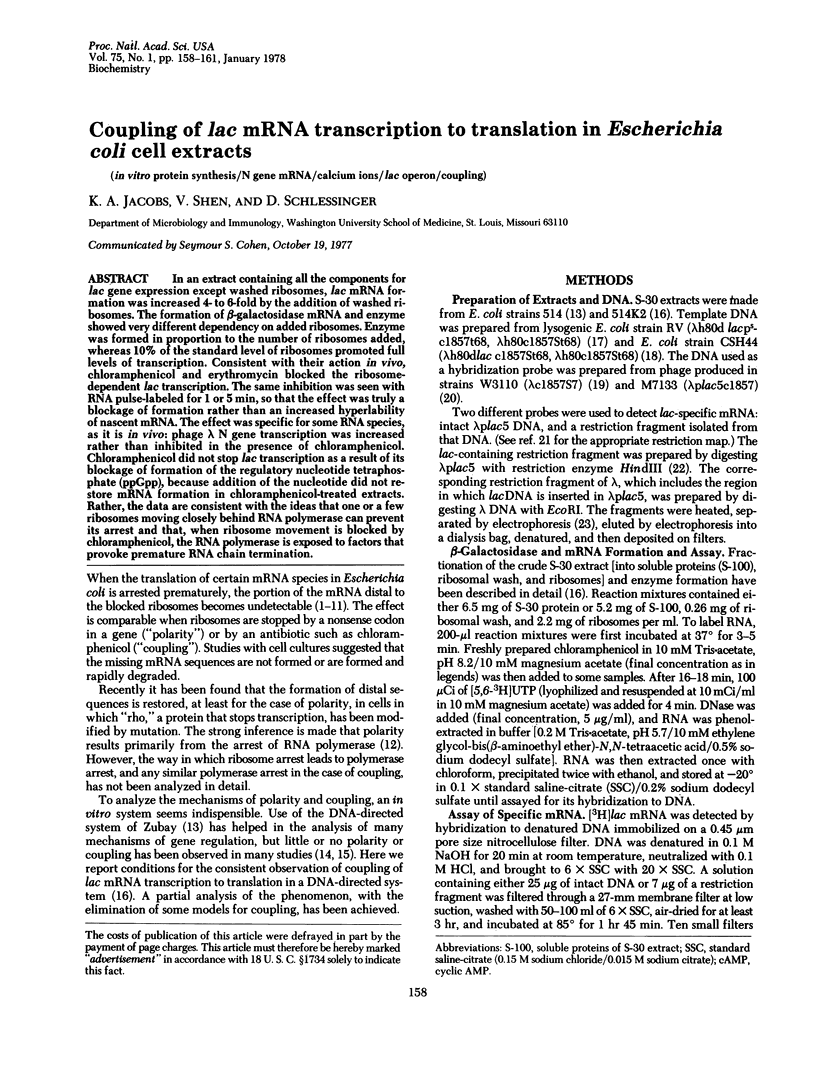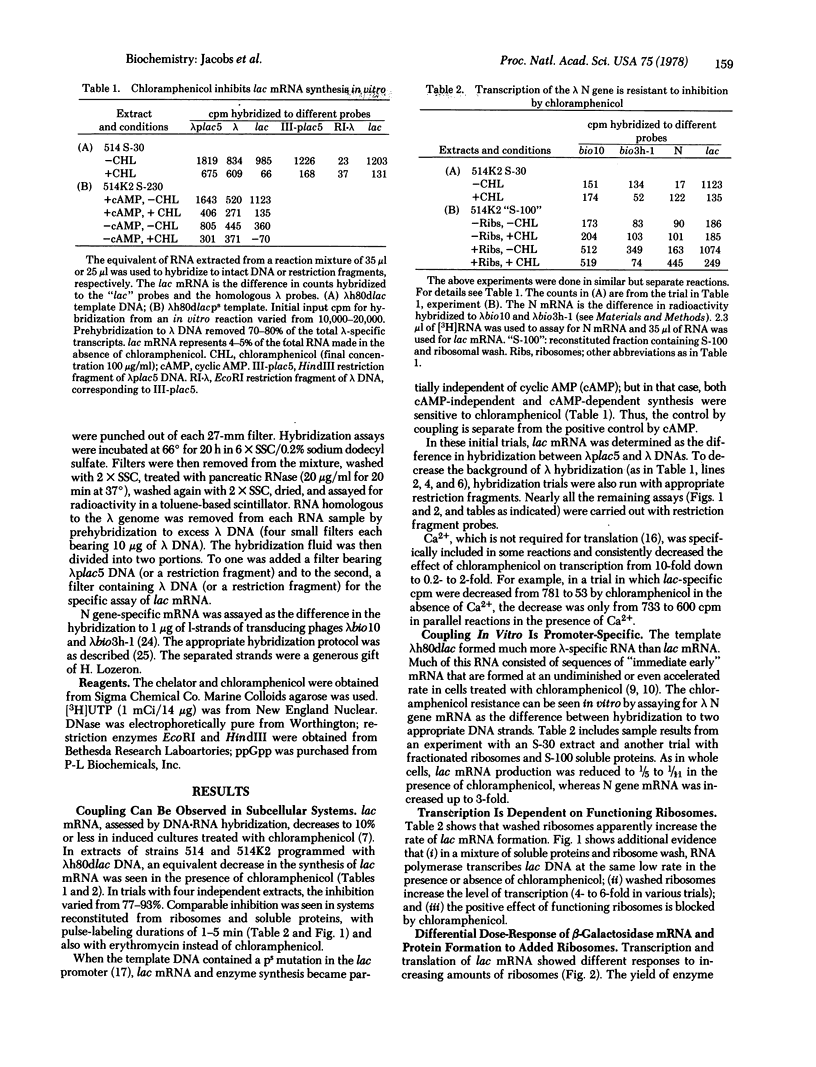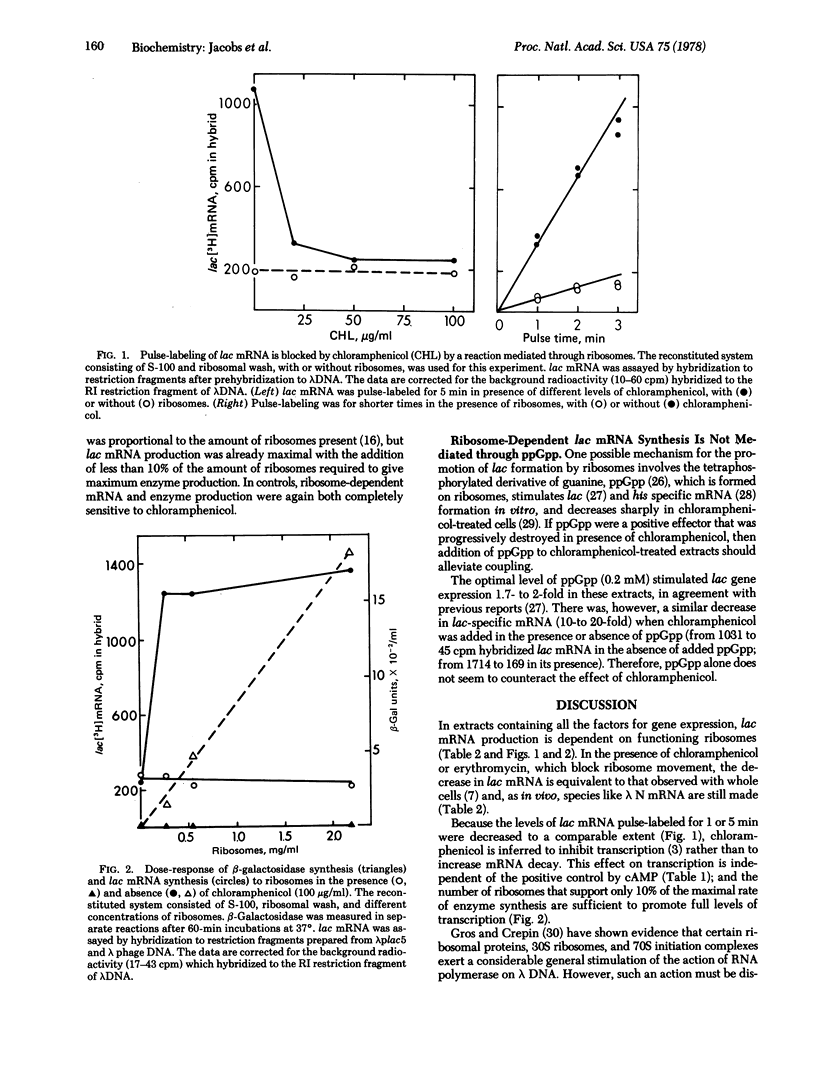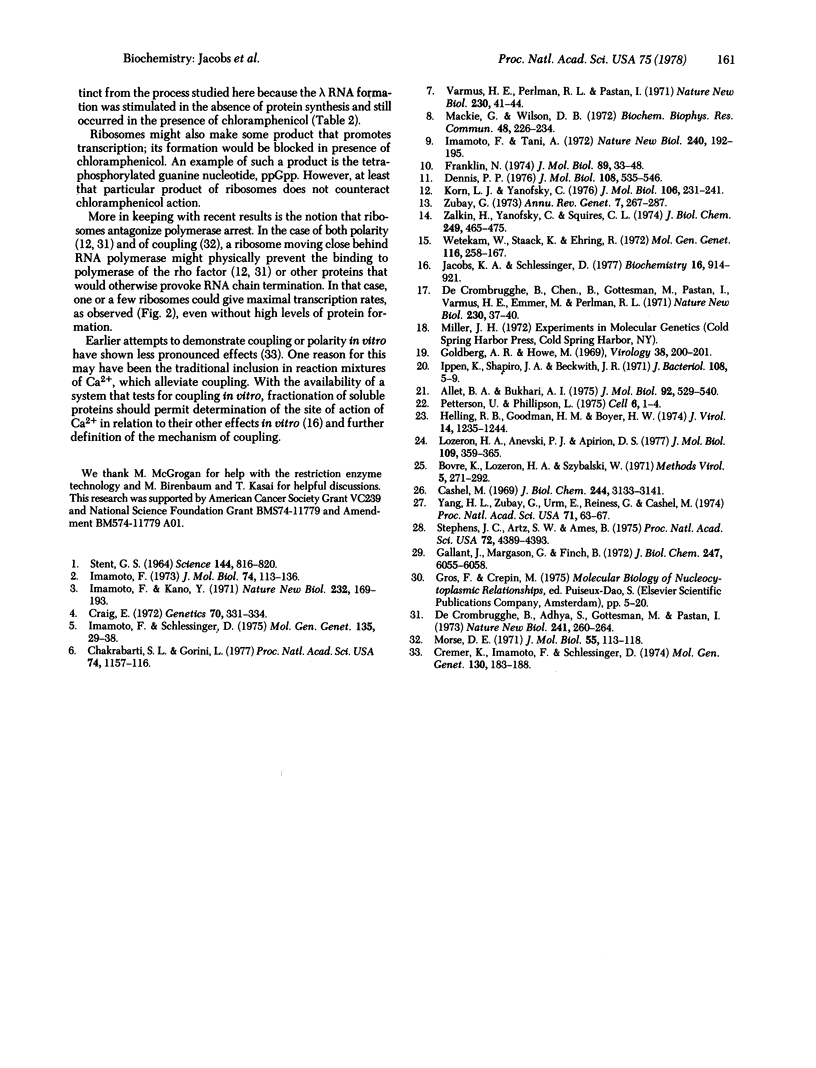Abstract
In an extract containing all the components for lac gene expression except washed ribosomes, lac mRNA formation was increased 4- to 6-fold by the addition of washed ribosomes. The formation of β-galactosidase mRNA and enzyme showed very different dependency on added ribosomes. Enzyme was formed in proportion to the number of ribosomes added, whereas 10% of the standard level of ribosomes promoted full levels of transcription. Consistent with their action in vivo, chloramphenicol and erythromycin blocked the ribosome-dependent lac transcription. The same inhibition was seen with RNA pulse-labeled for 1 or 5 min, so that the effect was truly a blockage of formation rather than an increased hyperlability of nascent mRNA. The effect was specified for some RNA species, as it is in vivo: phage λ N gene transcription was increased rather than inhibited in the presence of chloramphenicol. Chloramphenicol did not stop lac transcription as a result of its blockage of formation of the regulatory nucleotide tetraphosphate (ppGpp), because addition of the nucleotide did not restore mRNA formation in chloramphenicol-treated extracts. Rather, the data are consistent with the ideas that one or a few ribosomes moving closely behind RNA polymerase can prevent its arrest and that, when ribosome movement is blocked by chloramphenicol, the RNA polymerase is exposed to factors that provoke premature RNA chain termination.
Keywords: in vitro protein synthesis, N gene mRNA, calcium ions, lac operon, coupling
Full text
PDF



Selected References
These references are in PubMed. This may not be the complete list of references from this article.
- Allet B., Bukhari A. I. Analysis of bacteriophage mu and lambda-mu hybrid DNAs by specific endonucleases. J Mol Biol. 1975 Mar 15;92(4):529–540. doi: 10.1016/0022-2836(75)90307-1. [DOI] [PubMed] [Google Scholar]
- Cashel M. The control of ribonucleic acid synthesis in Escherichia coli. IV. Relevance of unusual phosphorylated compounds from amino acid-starved stringent strains. J Biol Chem. 1969 Jun 25;244(12):3133–3141. [PubMed] [Google Scholar]
- Chakrabarti S. L., Gorini L. Interaction between mutations of ribosomes and RNA polymerase: a pair of strA and rif mutants individually temperature-insensitive but temperature-sensitive in combination. Proc Natl Acad Sci U S A. 1977 Mar;74(3):1157–1161. doi: 10.1073/pnas.74.3.1157. [DOI] [PMC free article] [PubMed] [Google Scholar]
- Craig E. Synthesis of Specific, Stabilized Messenger RNA When Translocation Is Blocked in ESCHERICHIA COLI. Genetics. 1972 Feb;70(2):331–336. doi: 10.1093/genetics/70.2.331. [DOI] [PMC free article] [PubMed] [Google Scholar]
- Cremer K., Imamoto F., Schlessinger D. Limitation of transcription by puromycin or chloramphenicol in DNA-coupled systems from Escherichia coli. Mol Gen Genet. 1974 May 21;130(2):183–188. doi: 10.1007/BF00269089. [DOI] [PubMed] [Google Scholar]
- De Crombrugghe B., Adhya S., Gottesman M., Pastan I. Effect of Rho on transcription of bacterial operons. Nat New Biol. 1973 Feb 28;241(113):260–264. doi: 10.1038/newbio241260a0. [DOI] [PubMed] [Google Scholar]
- De Crombrugghe B., Chen B., Gottesman M., Pastan I., Varmus H. E., Emmer M., Perlman R. L. Regulation of lac mRNA synthesis in a soluble cell-free system. Nat New Biol. 1971 Mar 10;230(10):37–40. doi: 10.1038/newbio230037a0. [DOI] [PubMed] [Google Scholar]
- Dennis P. P. Effects of chloramphenicol on the transcriptional activities of ribosomal RNA and ribosomal protein genes in Escherichia coli. J Mol Biol. 1976 Dec 15;108(3):535–546. doi: 10.1016/s0022-2836(76)80135-0. [DOI] [PubMed] [Google Scholar]
- Franklin N. C. Altered reading of genetic signals fused to the N operon of bacteriophage lambda: genetic evidence for modification of polymerase by the protein product of the N gene. J Mol Biol. 1974 Oct 15;89(1):33–48. doi: 10.1016/0022-2836(74)90161-2. [DOI] [PubMed] [Google Scholar]
- Gallant J., Margason G., Finch B. On the turnover of ppGpp in Escherichia coli. J Biol Chem. 1972 Oct 10;247(19):6055–6058. [PubMed] [Google Scholar]
- Goldberg A. R., Howe M. New mutations in the S cistron of bacteriophage lambda affecting host cell lysis. Virology. 1969 May;38(1):200–202. doi: 10.1016/0042-6822(69)90148-2. [DOI] [PubMed] [Google Scholar]
- Helling R. B., Goodman H. M., Boyer H. W. Analysis of endonuclease R-EcoRI fragments of DNA from lambdoid bacteriophages and other viruses by agarose-gel electrophoresis. J Virol. 1974 Nov;14(5):1235–1244. doi: 10.1128/jvi.14.5.1235-1244.1974. [DOI] [PMC free article] [PubMed] [Google Scholar]
- Imamoto F. Diversity of regulation of genetic transcription. I. Effect of antibiotics which inhibit the process of translation on RNA metabolism in Escherichia coli. J Mol Biol. 1973 Feb 25;74(2):113–136. doi: 10.1016/0022-2836(73)90102-2. [DOI] [PubMed] [Google Scholar]
- Imamoto F., Kano Y. Inhibition of transcription of the tryptophan operon in Escherichia coli by a block in initiation of translation. Nat New Biol. 1971 Aug 11;232(2):169–173. doi: 10.1038/newbio232169a0. [DOI] [PubMed] [Google Scholar]
- Imamoto F., Schlessinger D. Bearing of some recent results on the mechanisms of polarity and messenger RNA stability. Mol Gen Genet. 1974;135(1):29–38. doi: 10.1007/BF00433898. [DOI] [PubMed] [Google Scholar]
- Ippen K., Shapiro J. A., Beckwith J. R. Transposition of the lac region to the gal region of the Escherichia coli chromosome: isolation of lambda-lac transducing bacteriophages. J Bacteriol. 1971 Oct;108(1):5–9. doi: 10.1128/jb.108.1.5-9.1971. [DOI] [PMC free article] [PubMed] [Google Scholar]
- Jacobs K. A., Schlessinger D. Escherichia coli DNA-directed beta-galactosidase synthesis in presence and absence of Ca2+. Biochemistry. 1977 Mar 8;16(5):914–920. doi: 10.1021/bi00624a016. [DOI] [PubMed] [Google Scholar]
- Korn L. J., Yanofsky C. Polarity suppressors defective in transcription termination at the attenuator of the tryptophan operon of Escherichia coli have altered rho factor. J Mol Biol. 1976 Sep 15;106(2):231–241. doi: 10.1016/0022-2836(76)90082-6. [DOI] [PubMed] [Google Scholar]
- Lozeron H. A., Anevski P. J., Apirion D. Antitermination and absence of processing of the leftward transcript of coliphage lambda in the RNAase III-deficient host. J Mol Biol. 1977 Jan 15;109(2):359–365. doi: 10.1016/s0022-2836(77)80039-9. [DOI] [PubMed] [Google Scholar]
- Mackie G., Wilson D. B. Polarity and transcription in the galactose operon of E. coli. Biochem Biophys Res Commun. 1972 Jul 11;48(1):226–234. doi: 10.1016/0006-291x(72)90367-1. [DOI] [PubMed] [Google Scholar]
- Morse D. E. Polarity induced by chloramphenicol and relief by suA. J Mol Biol. 1971 Jan 14;55(1):113–118. doi: 10.1016/0022-2836(71)90285-3. [DOI] [PubMed] [Google Scholar]
- Pettersson U., Philipson L. Location of sequences on the adenovirus genome coding for the 5.5S RNA. Cell. 1975 Sep;6(1):1–4. doi: 10.1016/0092-8674(75)90066-5. [DOI] [PubMed] [Google Scholar]
- STENT G. S. THE OPERON: ON ITS THIRD ANNIVERSARY. MODULATION OF TRANSFER RNA SPECIES CAN PROVIDE A WORKABLE MODEL OF AN OPERATOR-LESS OPERON. Science. 1964 May 15;144(3620):816–820. doi: 10.1126/science.144.3620.816. [DOI] [PubMed] [Google Scholar]
- Stephens J. C., Artz S. W., Ames B. N. Guanosine 5'-diphosphate 3'-diphosphate (ppGpp): positive effector for histidine operon transcription and general signal for amino-acid deficiency. Proc Natl Acad Sci U S A. 1975 Nov;72(11):4389–4393. doi: 10.1073/pnas.72.11.4389. [DOI] [PMC free article] [PubMed] [Google Scholar]
- Varmus H. E., Perlman R. L., Pastan I. Regulation of lac transcription in antibiotic-treated E. coli. Nat New Biol. 1971 Mar 10;230(10):41–44. doi: 10.1038/newbio230041a0. [DOI] [PubMed] [Google Scholar]
- Wetekam W., Staack K., Ehring R. Relief of polarity in DNA-dependent cell-free synthesis of enzymes of the galactose operon of Escherichia coli. Mol Gen Genet. 1972;116(3):258–276. doi: 10.1007/BF00269770. [DOI] [PubMed] [Google Scholar]
- Yang H. L., Zubay G., Urm E., Heiness G., Cashel M. Effects of guanosine tetraphosphate, guanosine pentaphosphate, and beta-gamma methylenyl-guanosine pentaphosphate on gene expression of Escherichia coli in vitro. Proc Natl Acad Sci U S A. 1974 Jan;71(1):63–67. doi: 10.1073/pnas.71.1.63. [DOI] [PMC free article] [PubMed] [Google Scholar]
- Zalkin H., Yanofsky C., Squires C. L. Regulated in vitro synthesis of Escherichia coli tryptophan operon messenger ribonucleic acid and enzymes. J Biol Chem. 1974 Jan 25;249(2):465–475. [PubMed] [Google Scholar]
- Zubay G. In vitro synthesis of protein in microbial systems. Annu Rev Genet. 1973;7:267–287. doi: 10.1146/annurev.ge.07.120173.001411. [DOI] [PubMed] [Google Scholar]


